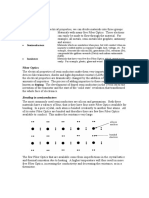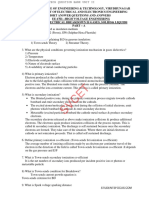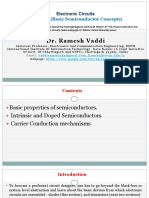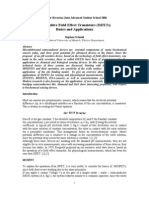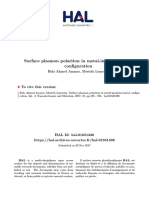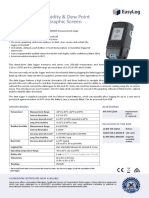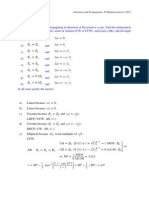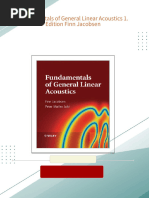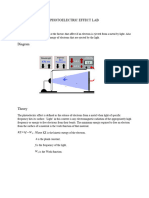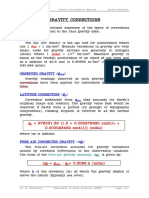Radiation Effects On Mosfets: Deepkumar R. Shah
Radiation Effects On Mosfets: Deepkumar R. Shah
Uploaded by
carlos ricardo herrera castilloCopyright:
Available Formats
Radiation Effects On Mosfets: Deepkumar R. Shah
Radiation Effects On Mosfets: Deepkumar R. Shah
Uploaded by
carlos ricardo herrera castilloOriginal Title
Copyright
Available Formats
Share this document
Did you find this document useful?
Is this content inappropriate?
Copyright:
Available Formats
Radiation Effects On Mosfets: Deepkumar R. Shah
Radiation Effects On Mosfets: Deepkumar R. Shah
Uploaded by
carlos ricardo herrera castilloCopyright:
Available Formats
1
Radiation Effects on MOSFETs
Deepkumar R. Shah
effects. SEEs appear for a very small interval of time and
Abstract— Electronic devices contain numerous types of oxides cause momentary change in the properties or function of the
and insulator materials. When these devices are brought in the device. Examples of SEEs include Single Event Transients
space environment, significant charge build-up in the oxides and (SETs), Single Event Upsets (SEUs), Single Event Functional
insulators induced because of the ionizing radiation can cause Interrupts (SEFIs), etc. In this paper, we discuss the effects of
device degradation and failure. Electrons, protons, alpha-
radiation on oxide-induced device degradation and failure,
particles, etc. in the space can lead to radiation-induced total
ionizing dose effects and Single Event Effects (SEEs). Moreover,
radiation-induced charge build up, heavy ion induced
heavy ions in the space can also cause degradation in oxides mechanisms and properties, TID effects, SEEs, degradation of
through different mechanisms like Single Event Gate Rupture, electrical properties of the MOSFETs and need for radiation
Oxide Breakdown, Displacement Damage, etc. This effects can hardening.
alter the electrical properties of the devices. This review paper
discusses the various radiation effects on MOSFETs, electrical II. TOTAL IONIZING DOSE EFFECTS
properties that are altered by this radiation effects and the need
for radiation hardening. A. Overview
High energy electrons (like the ones present in the
Index Terms— MOSFETs, radiation effects, SEEs, total-dose
effects environment or photon generated secondary electrons) and
protons can ionize the atoms and generate electron-hole pairs.
Until the electrons and holes generated by these particles have
I. INTRODUCTION energy greater than the minimum energy required to generate
electron-hole pairs, additional electron-hole pairs will be
Since various kinds of radiation particles are present in the generated by them. In this way, a single high energy particle or
space and other radiation environments, electronic radiation photon can generate thousands of electron-hole pairs.
hardening parts are used in the space applications. There are
basically two types of radiation: particle radiation and photon When MOSFETs are subjected to such high energy radiation
radiation [1]. Particle radiation consists of charged as well as particles, electron-hole pairs are generated in the oxide. This
neutral particles such as protons, electrons, ions, alpha
electron-hole pair generation in the oxide is the prime reason
particles and neutrons. On the other hand, photon radiation
that leads to almost all TID effects. Charge build up induces in
consists of high energy x-rays and gamma rays. Different units
the oxide that can cause device failure. The mechanism of
for both types of radiation when dealing with their radiation
effects. When dealing with photon radiation, the unit used is charge build up and device degradation is shown in Fig. 1. Fig.
rad. A rad is the amount of photon radiation which deposits 1 is a plot of the energy band diagram for a MOSFET with p-
100 ergs of energy per gram of a given material. When dealing substrate, n-channel and positive gate bias. As soon as the
with particle radiation, the units are flux (number/cm2s) and electron-hole pairs are created, the electrons will drift towards
fluence (number/cm2). The parameters of the radiation the gate and the holes will move towards the oxide-Si interface
particles such as particle mass, particle energy, particle due to the presence of positive gate bias. However, some of
species, target temperature, total dose and flux/fluence can the electrons will recombine with holes. The fraction of
give effect to the amount of radiation damage by the radiation electron-hole pairs that escape recombination is called the
[2]. This can affect the electrical, mechanical, optical, charge yield. On the other hand, those holes which escape
magnetic and superconducting properties of the material. “initial” recombination will transport through the oxide toward
the Si/oxide interface by hopping through localized states in
Oxides and insulators are the key components of all the oxide. As the holes approach the Si/oxide interface, some
electronic devices from MOSFETs to bipolar ICs. Charge fraction of the holes will be trapped, forming a positive oxide-
build up in the oxides and insulators due to ionizing radiation trap charge. It is believed that protons (hydrogen ions) are
can lead to device degradation and failure. In harsh radiation likely released as holes “hop” through the oxide or as they are
environments, exposure to high energy photons and electrons trapped near the Si/oxide interface. The hydrogen ions can
can significantly reduce the life-time of the system due to total also drift to the Si/oxide interface where they may react to
dose effects. Also, there are some single event effects that are
form interface traps. At threshold, the interface traps are
short term. TID is a long term effect which permanently
predominantly positively charged for p-channel MOSFETs
damages the device while SEEs are short term single event
and negatively charged for n-channel MOSFETs.
2
Nh = f(Eox)g0Dtox (1)
Here, f(Eox) is the hole yield as a function of the electric field,
g0 is a material-dependent parameter that gives the initial
charge pair density per rad of dose, D is the dose and tox is the
oxide thickness.
C. Oxide Traps
The mobility of holes is less than that of electrons. In the
presence of an electric field, the generated holes can travel to
gate/oxide interface (negative bias) or oxide/Si interface
(positive bias). Due to its positive charge, as a hole moves
along in the oxide, it causes a distortion of the potential field
of the oxide. This potential distortion increases the trap depth
Fig. 1. Band Diagram of a MOS Capacitor with a positive gate at the site and tends to trap itself at that site. Hence, the hole
bias. The main processes for radiation-induced charge tries to trap itself at the localized site.
generation are illustrated [3]
When a positive gate bias is applied, holes transport to the
In addition to the oxide-trapped charge and interface-trap oxide/Si interface. Near the interface there are a large number
charge build-up in gate oxides, charge build-up will also occur of oxygen vacancies because of the “out-diffusion” of oxygen
in other oxides including the field oxides and alternate in the oxide and lattice mismatch at the surface [3]. These
dielectrics. The radiation-induced charge build-up in these oxygen vacancies can act as trapping centres. Some fraction of
dielectrics can cause device degradation and circuit failure. the holes will be trapped as holes approach the interface. The
Positive charge trapping in the gate oxide inverts the channel number of holes that are trapped is given by the capture cross-
interface causing leakage current to flow in the “Off” state section area near the interface. This is dependent on the
condition. This results in an increase in the static power supply applied field (gate bias) and is highly device fabrication
current of the IC and may also cause IC failure. In a similar dependent, with only a few percent of the holes being trapped
fashion, positive charge build-up in the field oxides causes in hardened oxides to as much as 50-100% for soft oxides [3].
large increases in IC static power supply leakage current. In The positive charge associated with trapped holes causes a
fact, for advanced ICs with ultra-thin gate oxides, radiation- negative threshold-voltage shift in both nMOS and pMOS
induced charge build-up in field oxides normally dominates transistors.
the radiation-induced degradation of ICs. Large concentrations D. Interface Traps
of interface-trap charge decreases the mobility of carriers and Now, in addition to the formation of oxide traps, radiation
increases the threshold voltage of n-channel MOS transistors. also leads to the formation of interface traps. These interface
These effects tend to decrease the drive of transistors which in traps can be positive, negative or neutral. Also, they exist
turn degrades the timing parameters of an IC. within the silicon band gap, at the interface. Because of the
B. Charge Yield presence of these traps at the interface, its charge can be easily
If there is an electrical field existing across the oxide of a changed by applying a specific gate bias. Traps in the lower
MOSFET, electrons in the conduction band and holes in the portion of the band gap donate an electron to silicon and are
valence band will immediately transport in the opposite thus, donors. Therefore, for pMOS transistor, the interface
directions. Electrons are highly mobile in the oxide and are traps are positively charged which cause negative threshold
easily swept out of the oxide. Still, before leaving the oxide, voltage shifts. On the other hand, traps in the upper portion of
some fraction of the electrons recombine with the holes of the the band gap accept an electron from silicon and are thus,
valence band. This is called initial recombination. This initial acceptors. Therefore, for nMOS transistor, the interface traps
recombination is dependent on the electric field in the oxide are negatively charged which cause positive threshold voltage
and the energy/type of the incident radiation particle [4]. In shifts. For interface traps at the mid-gap, they are
short, strongly ionizing particles form dense columns of charge approximately neutral. As the oxide trap charge is positive for
and thus, the recombination rate is higher. On the other hand, both nMOS and pMOS transistors, interface trap charge and
weakly ionizing particles generate isolated charge pairs and oxide trap charge compensate each other for nMOS transistors
thus, the recombination rate is lower. In terms of strength of and add together for pMOS transistors [3].
the electric field, as the strength of the electric field increases,
the recombination probability of the hole decreases. The E. Field Isolation Leakage
fraction of un-recombined holes increases. According to [5], As the thickness of the gate oxide has kept on decreasing
the total number of holes generated in the oxide that escape the with the scaling of CMOS technology, less charge can be
initial recombination Nh is given by, trapped in this thin oxide. This trapped charge can be easily
3
neutralized by thermal emission and electron tunnelling [6].
Because of this, charge trapping in the thicker field isolation
oxide has become a grave concern for modern CMOS
technology as compared to the charge trapping in gate oxide.
Due to charge trapping in the field oxide, there is a leakage
current that flows between transistors which can cause
transistor cross-talk and thus, device failure or functional
failure. This is not particularly a transistor effect of radiation
but an IC effect.
F. Particle Micro-dose Effects
When total dose effects are caused by individual energetic
particles, they are called micro-dose effects. These are nothing
but an intersection of total dose effects and SEEs [7]. It can be
also called Single Event Total Dose (SETD). These are total
dose effects occurring as a single event and causing total dose
failure of a single transistor. Such single energetic particle can
cause device failure and thus, were studied independently from
total dose effects. To mitigate unexpected failures of MOS
devices in proton-rich or other charged-particle-rich space
environments and to avoid underestimation of radiation-
induced degradation by gamma ray testing of devices, particle
micro dose effects are studied. This provided device reliability
assurance for charge-rich space environments. Fig. 2. Variation in the threshold voltage, VTH after 8 MeV
electron irradiation [9]
III. DEGRADATION IN ELECTRICAL PROPERTIES OF
MOSFETS
A. Threshold Voltage Shifts
Threshold voltage for both nMOS and pMOS transistors
shift due to radiation induced oxide trapped charge (N ot) and
interface trapped charge (Nit). The contributions of Nit and Not
are additive for pMOS transistors and subtractive for nMOS
transistors as discussed earlier. Both types of charges change
with the post-irradiation time, temperature and electrical
conditions. This is turn varies the threshold voltage as well.
TID threshold voltage shifts depend on the thickness of the
oxide (t) according to a power law (tn), where n can be
between 1 and 2 or 2 or 3 depending on the electrical biasing
effects and processing [8]. The caveat to this is that the oxides
with thickness less than 10 nm show almost no radiation-
induced threshold voltage shifts. Figures 2 and 3 show the
variation in the threshold voltage due to TID.
B. Sub-Threshold Slope
Radiation-induced sub-threshold slope is affected by both
trapped interface charge (Nit) and lateral non-uniformity of
Fig. 3. Net threshold voltage shift and contributions to that
trapped oxide charge (Not) [8]. Lateral non-uniformity of Not
shift due to interface traps and trapped-oxide charge for 8
can be caused by a non-uniform deposition of charge or by a
MeV electron irradiated MOSFET. [9]
non-uniform distribution of traps. These effects degrade the
device performance by increasing leakage currents.
C. Transconductance
The Transconductance (gm) of the MOS transistor is
decreased by radiation-induced reduction in carrier mobility
(µ) in the device channel caused by charges trapped at, or very
4
close to, the Si/oxide interface [8]. Transconductance also can E. 1/f Noise
be reduced by increase in surface resistivity such as would be
caused in a MOSFET with Lightly Doped Drain (LDD) Flicker noise or 1/f noise increases because of TID. This is
regions intended to reduce hot carrier reliability effects. correlated to the presence of oxide trapped charges and
interface trapped charges in the oxides [8]. An increase in the
Radiation-induced trapped charge in the field/spacer oxide,
flicker noise is detrimental to the phase noise of high
used to fabricate the LDD region, has been found to deplete p-
frequency transceiver front-end circuits (e.g. mixers and VCOs
type LDDs, increasing the resistivity and causing degradation
i.e. Voltage Controlled Oscillators) as well as base band
in Transconductance without affecting the mobility (µ). communications applications such as data converters and
Transconductance affects the speed and output drive of the filters [10].
MOSFET. Any change in the value of gm affects the
performance of the transistor. Figures 4 and 5 show the change F. Gate Oxide Stability and Breakdown
in gm and peak value of gm due to TID.
We know that radiation induced trapped charges affect the
oxide leakage current but these charges also affect the
breakdown voltage of oxides. It has been observed that the
trapped charges increase the oxide leakage current and reduce
the oxide breakdown voltage. This occurs due to electron trap
assisted tunnelling for total dose irradiations greater than 1
Mrad (Si) [8].
G. Mobility
Mobility of the carriers in the channel of a MOSFET can be
determined from the value of gm and peak value of gm. With
the change in the value of Transconductance due to TID, the
mobility of the MOSFET also changes. This affects the speed
of the MOSFET device. The relation between gm and µ is
given by
Fig. 4. Variation in gm after 8 MeV electron irradiation (at VDS
gm = (ZµCox/L)VDS (2)
= 0.1 V) [9]
Here, Z is the width of the device, L is the length of the device,
µ is the mobility of the device and Cox is the oxide capacitance
per unit area. Figures 6 and 7 show the variation in device
mobility due to TID and also as a function of the interface
trapped charge.
IV. SINGLE EVENT EFFECTS OVERVIEW
While TID effects are long term effects, SEEs are short term
effects. The charge deposited by a single ionizing particle can
produce a wide range of SEEs, including Single-Event Upsets
(SEU), Single-Event Transients (SET), Single-Event
Dielectric Ruptures (SEDR), Single-Event Functional
Interrupts (SEFI), Single-Event Latchups (SEL), etc. SEEs can
be produced by direct ionization (primary charged particles) or
Fig. 5. Variation in gmPeak after 8 MeV electron irradiation [9] by secondary particles resulting from elastic collisions or
nuclear reactions. High-speed ICs exhibit increased
D. Channel and Junction Leakage Current vulnerabilities to SEEs, including multiple-bit upsets that
result from aggressive scaling, and large enhancements relative
GIDL (Gate-Induced Drain Leakage) current is increased by
to ion-strike angle that are much greater than for earlier
Total Ionizing Dose (TID) [8]. Trapped charge build-up in
lateral oxide isolation regions (i.e. field oxide structures) generations of technology [11]. SEUs are responsible for
increases transistor edge leakage current and changes the device soft failure. SETs do not directly cause upsets but may
junction breakdown voltage (degradation in nMOS transistors propagate through the logic. SEFIs can cause functional failure
and enhancement in pMOS transistors). and needs device reconfiguration or power reset for recovery.
As SEEs affect the circuit as a whole and not the MOSFET,
SEEs are not discussed in detail here. Detailed explanation of
5
various SEEs is given in [7]. V. IMPORTANCE OF RADIATION HARDENING
Radiation hardening of MOS devices and circuits require
specialized design, layout and/or processing steps. There are
two types of radiation hardening: Radiation Hardening by
Design (RHBD) and Radiation Hardening by Process (RHBP).
RHBD deals with hardening by adding more transistors at
circuit level and redundancy along with a majority voter circuit
at system level [12]. Some techniques even use the concept of
feedback and delay elements to mitigate SETs. RHBP deals
with specific techniques to reduce the number of
traps/recombination centres in the oxide [8]. As RHBP
requires additional processing steps, it is costlier than RHBD.
With more and more number of transistors being able to fit in
the same size of an IC through scaling, adding more transistors
than necessary, to reduce radiation effects has gained more
importance.
VI. CONCLUSION
To sum up, it is very important to study radiation effects to
make reliable space electronics. Various properties of the
materials are varied in the space environment due to TID and
SEEs. To mitigate these effects, RHBP and RHBD are used
extensively for space applications.
Fig. 6. Variation in normalized mobility after 8 MeV electron
irradiation [9] REFERENCES
[1] Y. H. Lho, K. Y. Kim, “Radiation Effects on the Power MOSFET for
Space Applications,” ETRI Journal, vol. 27, no. 4, Aug. 2005, pp. 449-452.
DOI: 10.4218/etrij.05.0205.0031
[2] H. F. A. Amir, F. P. Chee, S. Salleh, “Effects of High Energy Neutrons
and Resulting Secondary Charged Particles on the Operation of MOSFETs,”
Computational Science and Technology (ICCST), 2014 International
Conference, pp. 1-6, 2014.
[3] J. R. Schwank, M. R. Shaneyfelt, D. M. Fleetwood, et al., “Radiation
Effects in MOS Oxides,” IEEE Trans. Nuclear Science, Vol. 55, no. 4, pp.
1833-1853, 2008.
[4] F. B. McLean, H. E. Boesch Jr., and T. R. Oldham, “Electron-hole
generation, transport, and trapping in SiO2,” in Ionizing Radiation Effects in
MOS Devices and Circuits, T. P. Ma and P. V. Dressendorfer, Eds. New
York: Wiley, 1989, pp. 87–192.
[5] F. B. McLean and T. R. Oldham, “Basic Mechanisms of Radiation Effects
in Electronic Materials and Devices,” Harry Diamond Laboratory, Tech. Rep.
HDL-TR-2129, 1987.
[6] P. J. McWhorter, S. L.Miller, and W. M. Miller, “Modeling the anneal of
radiation-induced trapped holes in a varying thermal environment,” IEEE
Trans. Nuclear Science, vol. 37, no. 6, pp. 1682–1689, Dec. 1990.
[7] P. E. Dodd, M. R. Shaneyfelt, J. R. Schwank, J. A. Felix, “Current and
Future Challenges in Radiation Effects on CMOS Electronics,” IEEE Trans.
Nuclear Science, vol. 57, no. 4, pp. 1747-1763, 2010.
[8] H. L. Hughes, J. M. Benedetto, “Radiation Effects and Hardening of MOS
Technology: Devices and Circuits,” IEEE Trans. Nuclear Science, vol. 50,
no. 3, pp. 500-521, 2003.
[9] Prakash, AP Gnana, S. C. Ke, and K. Siddappa. "High-energy radiation
effects on subthreshold characteristics, transconductance and mobility of n-
channel MOSFETs," Semiconductor science and technology, vol. 18, no.12,
pp. 1037-1042, 2003.
[10] K. W. Chew, K. S. Yeo, and S. F. Chu, “Impact of technology scaling on
the 1/f noise of thin and thick gate oxide deep submicron NMOS transistors,”
IEE Proc. Circuits Devices Syst., vol. 151, pp. 415–421, 2004.
[11] R. D. Schrimpf, K. M. Warren, R. A. Weller, R. A. Reed, et al.,
Fig. 7. Normalized mobility degradation during irradiation as a “Reliability And Radiation Effects in IC Technologies,” 2008 IEEE
function of interface trapped charge Nit [9] International Reliability Physics Symposium, pp. 97-106, 2008.
[12] T. Calin, M. Nicolaidis, and R. Velazco, “Upset hardened memory
design for submicron CMOS technology,” IEEE Trans. Nuclear Science, vol.
43, no. 6, pp. 2874–2878, Dec. 1996.
You might also like
- Electrical Discharge in Gases and Principles of Ion Nitriding, E Rolinsky, 2009, (24p)No ratings yetElectrical Discharge in Gases and Principles of Ion Nitriding, E Rolinsky, 2009, (24p)24 pages
- Thin Gate Oxide Damage Due To Plasma ProcessingNo ratings yetThin Gate Oxide Damage Due To Plasma Processing12 pages
- XPS (X Ray Photoemission Spectroscopy) /ESCA (Electron Spectroscopy For Chemical Analysis)No ratings yetXPS (X Ray Photoemission Spectroscopy) /ESCA (Electron Spectroscopy For Chemical Analysis)46 pages
- Dr. Ramesh Vaddi: Electronic Circuits (ECE-106)100% (1)Dr. Ramesh Vaddi: Electronic Circuits (ECE-106)36 pages
- Application of Modern Physics in Electronics100% (1)Application of Modern Physics in Electronics12 pages
- Engineering Journal Effect of Radiation On Electrical Characteristic Measurement of The Fabricated CdTe / P-Si Heterojunction Solar CellNo ratings yetEngineering Journal Effect of Radiation On Electrical Characteristic Measurement of The Fabricated CdTe / P-Si Heterojunction Solar Cell6 pages
- Photoelectric Effects in SemiconductorsNo ratings yetPhotoelectric Effects in Semiconductors10 pages
- Electrical Conduction: V/L, Ohm's Law Can Then Be Expressed in Terms of TheNo ratings yetElectrical Conduction: V/L, Ohm's Law Can Then Be Expressed in Terms of The10 pages
- Photodiode Are Semiconductor Light Sensor That Generate A Current or Voltage When The P-NNo ratings yetPhotodiode Are Semiconductor Light Sensor That Generate A Current or Voltage When The P-N4 pages
- Nanostructures As Single Electron TransistorNo ratings yetNanostructures As Single Electron Transistor16 pages
- Improving Electric Energy Result by Using Composition WavelengthNo ratings yetImproving Electric Energy Result by Using Composition Wavelength5 pages
- Ion Sensitive Field Effect Transistors (Isfets) Basics and ApplicationsNo ratings yetIon Sensitive Field Effect Transistors (Isfets) Basics and Applications8 pages
- JEE Main Dual Nature of Matter and Radiation Revision Notes Free PDFNo ratings yetJEE Main Dual Nature of Matter and Radiation Revision Notes Free PDF8 pages
- Corona Discharge - Wikipedia, The Free EncyclopediaNo ratings yetCorona Discharge - Wikipedia, The Free Encyclopedia8 pages
- Applied Physics Important Questions-II MidNo ratings yetApplied Physics Important Questions-II Mid7 pages
- Calorimetry and Thermodynamics in Drug Design: Jonathan B. ChairesNo ratings yetCalorimetry and Thermodynamics in Drug Design: Jonathan B. Chaires19 pages
- LPCMSQCOMM170126 MSQ QuickRefGuide Promote PlanNo ratings yetLPCMSQCOMM170126 MSQ QuickRefGuide Promote Plan1 page
- EL-GFX-2: Temperature, Humidity & Dew Point Data Logger With Graphic ScreenNo ratings yetEL-GFX-2: Temperature, Humidity & Dew Point Data Logger With Graphic Screen4 pages
- Agitation: Introduction To Principles and Practice100% (9)Agitation: Introduction To Principles and Practice44 pages
- School of Electrical, Electronics and Computer Engineering: EE101L/B6No ratings yetSchool of Electrical, Electronics and Computer Engineering: EE101L/B69 pages
- Design and Construction of Embankment Dams100% (3)Design and Construction of Embankment Dams33 pages
- Fundamentals of General Linear Acoustics 1. Edition Finn Jacobsen 2024 Scribd Download100% (3)Fundamentals of General Linear Acoustics 1. Edition Finn Jacobsen 2024 Scribd Download51 pages
- Fluid Mechanics (2) : Dr. Ali Mahmoud Ali Attia ME 413No ratings yetFluid Mechanics (2) : Dr. Ali Mahmoud Ali Attia ME 4137 pages
- By Dr. Mohammed Ramidh: Engineering Materials DesignNo ratings yetBy Dr. Mohammed Ramidh: Engineering Materials Design114 pages
- In Order To Determine The Motion of A Rigid Body, Under The Action of External Forces, It Is Convenient To Replace The Rigid Body by Two Masses Placed at Fixed Distance ApartNo ratings yetIn Order To Determine The Motion of A Rigid Body, Under The Action of External Forces, It Is Convenient To Replace The Rigid Body by Two Masses Placed at Fixed Distance Apart7 pages
- Theory of Helix-Coil Transition: Loukas Petridis Monday April 7 2008No ratings yetTheory of Helix-Coil Transition: Loukas Petridis Monday April 7 200817 pages
- Mechanics of Materials Theory - KesavarajNo ratings yetMechanics of Materials Theory - Kesavaraj13 pages
- Effect of Harmonic Currents On Semiconductor Fuse Ratings: R Wilkins J. F. de Palma C. MulerttNo ratings yetEffect of Harmonic Currents On Semiconductor Fuse Ratings: R Wilkins J. F. de Palma C. Mulertt6 pages
- 66166edefb1ec60018c1cf26 - ## - Neev 2025 Test PlannerNo ratings yet66166edefb1ec60018c1cf26 - ## - Neev 2025 Test Planner1 page
- Electrical Discharge in Gases and Principles of Ion Nitriding, E Rolinsky, 2009, (24p)Electrical Discharge in Gases and Principles of Ion Nitriding, E Rolinsky, 2009, (24p)
- XPS (X Ray Photoemission Spectroscopy) /ESCA (Electron Spectroscopy For Chemical Analysis)XPS (X Ray Photoemission Spectroscopy) /ESCA (Electron Spectroscopy For Chemical Analysis)
- Engineering Journal Effect of Radiation On Electrical Characteristic Measurement of The Fabricated CdTe / P-Si Heterojunction Solar CellEngineering Journal Effect of Radiation On Electrical Characteristic Measurement of The Fabricated CdTe / P-Si Heterojunction Solar Cell
- Electrical Conduction: V/L, Ohm's Law Can Then Be Expressed in Terms of TheElectrical Conduction: V/L, Ohm's Law Can Then Be Expressed in Terms of The
- Photodiode Are Semiconductor Light Sensor That Generate A Current or Voltage When The P-NPhotodiode Are Semiconductor Light Sensor That Generate A Current or Voltage When The P-N
- Improving Electric Energy Result by Using Composition WavelengthImproving Electric Energy Result by Using Composition Wavelength
- Ion Sensitive Field Effect Transistors (Isfets) Basics and ApplicationsIon Sensitive Field Effect Transistors (Isfets) Basics and Applications
- JEE Main Dual Nature of Matter and Radiation Revision Notes Free PDFJEE Main Dual Nature of Matter and Radiation Revision Notes Free PDF
- Corona Discharge - Wikipedia, The Free EncyclopediaCorona Discharge - Wikipedia, The Free Encyclopedia
- Calorimetry and Thermodynamics in Drug Design: Jonathan B. ChairesCalorimetry and Thermodynamics in Drug Design: Jonathan B. Chaires
- EL-GFX-2: Temperature, Humidity & Dew Point Data Logger With Graphic ScreenEL-GFX-2: Temperature, Humidity & Dew Point Data Logger With Graphic Screen
- Agitation: Introduction To Principles and PracticeAgitation: Introduction To Principles and Practice
- School of Electrical, Electronics and Computer Engineering: EE101L/B6School of Electrical, Electronics and Computer Engineering: EE101L/B6
- Fundamentals of General Linear Acoustics 1. Edition Finn Jacobsen 2024 Scribd DownloadFundamentals of General Linear Acoustics 1. Edition Finn Jacobsen 2024 Scribd Download
- Fluid Mechanics (2) : Dr. Ali Mahmoud Ali Attia ME 413Fluid Mechanics (2) : Dr. Ali Mahmoud Ali Attia ME 413
- By Dr. Mohammed Ramidh: Engineering Materials DesignBy Dr. Mohammed Ramidh: Engineering Materials Design
- In Order To Determine The Motion of A Rigid Body, Under The Action of External Forces, It Is Convenient To Replace The Rigid Body by Two Masses Placed at Fixed Distance ApartIn Order To Determine The Motion of A Rigid Body, Under The Action of External Forces, It Is Convenient To Replace The Rigid Body by Two Masses Placed at Fixed Distance Apart
- Theory of Helix-Coil Transition: Loukas Petridis Monday April 7 2008Theory of Helix-Coil Transition: Loukas Petridis Monday April 7 2008
- Effect of Harmonic Currents On Semiconductor Fuse Ratings: R Wilkins J. F. de Palma C. MulerttEffect of Harmonic Currents On Semiconductor Fuse Ratings: R Wilkins J. F. de Palma C. Mulertt
- 66166edefb1ec60018c1cf26 - ## - Neev 2025 Test Planner66166edefb1ec60018c1cf26 - ## - Neev 2025 Test Planner


